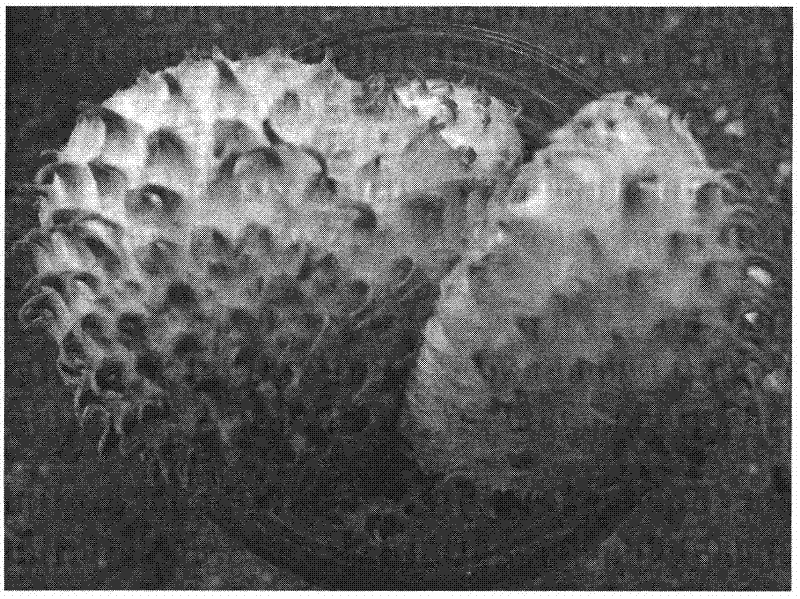Method for separating, domesticating and cultivating wild Pholiota squarrosa strain
A technology for strain separation and cultivation methods, applied in botany equipment and methods, fertilizer mixtures, horticulture, etc., can solve problems such as artificial domestication and cultivation
- Summary
- Abstract
- Description
- Claims
- Application Information
AI Technical Summary
Problems solved by technology
Method used
Image
Examples
Embodiment 1
[0021] Strain isolation:
[0022] a. Using conventional PDA medium, the tissue separation method is used to separate the bacterial block from the cap of the wild Cinnamon chinensis, and then take 5 pieces of bacterial blocks of about 1 square millimeter, inoculate them in 5 test tubes, and cultivate them at 25°C 25 days to obtain tawny mother species;
[0023] Liquid propagation of strains:
[0024] b, using shake flasks to cultivate and propagate mother species to obtain cultivars, the liquid propagation medium is: potato 100g / L, bran 15g / L, maltose 25g / L, yeast powder 3g / L, potassium dihydrogen phosphate 0.5g / L L, dipotassium hydrogen phosphate 1g / L and magnesium sulfate 0.5g / L, insert the mother seed of the test tube into the liquid propagation medium, the temperature is 25°C, and cultivate for 10 days to obtain the cultivar;
[0025] Cultivation medium formula and production:
[0026] c. Weigh 50.7% of sawdust, 25% of cottonseed hulls, 15% of bran, 6% of cornmeal, 3% of...
Embodiment 2
[0032] Strain isolation:
[0033] a. Using conventional PDA medium, use the tissue separation method to separate the bacterial block from the cap of the wild cymbidium rotundum, and then take 5 bacterial blocks of about 1 square millimeter and inoculate them in 5 test tubes at a temperature of 25°C Cultivate for 30 days to obtain the tawny mother species;
[0034] Liquid propagation of strains:
[0035] b, using shake flasks to cultivate and propagate mother species to obtain cultivars, the liquid propagation medium is: potato 150g / L, bran 12g / L, maltose 23g / L, yeast powder 3g / L, potassium dihydrogen phosphate 0.5g / L L, dipotassium hydrogen phosphate 1g / L and magnesium sulfate 0.5g / L, insert the mother seed of the test tube into the liquid medium, and cultivate it for 13 days to obtain the cultivar at a temperature of 25°C;
[0036] Cultivation medium formula and production:
[0037] c. Weigh 68.9% of sawdust, 15.5% of cottonseed hulls, 12.5% of bran, 4% of cornmeal, 1% o...
Embodiment 3
[0043] Strain isolation:
[0044] a. Using conventional PDA medium, separate the mother species from the cap of the wild C. chinensis by tissue separation method, then take 5 pieces of bacteria blocks of about 1 square millimeter, and inoculate them in 5 test tubes respectively, and cultivate them at 25°C Obtain tawny mother species in 35 days;
[0045] Liquid propagation of strains:
[0046] b, using shake flasks to cultivate and propagate mother species to obtain cultivars, the liquid propagation medium is: potato 200g / L, bran 10g / L, maltose 20g / L, yeast powder 2g / L, potassium dihydrogen phosphate 0.5g / L L, dipotassium hydrogen phosphate 1g / L and magnesium sulfate 0.5g / L, insert the mother seed of the test tube into the liquid medium, and cultivate it for 15 days at a temperature of 25°C to obtain the cultivar;
[0047] Cultivation medium formula and production:
[0048] c. Weigh 59.8% of sawdust, 20% of cottonseed hulls, 13% of bran, 5% of cornmeal, 2% of gypsum, and 0.2...
PUM
 Login to View More
Login to View More Abstract
Description
Claims
Application Information
 Login to View More
Login to View More - R&D
- Intellectual Property
- Life Sciences
- Materials
- Tech Scout
- Unparalleled Data Quality
- Higher Quality Content
- 60% Fewer Hallucinations
Browse by: Latest US Patents, China's latest patents, Technical Efficacy Thesaurus, Application Domain, Technology Topic, Popular Technical Reports.
© 2025 PatSnap. All rights reserved.Legal|Privacy policy|Modern Slavery Act Transparency Statement|Sitemap|About US| Contact US: help@patsnap.com


